Oasis Change Characteristics and Influencing Factors in the Shiyang River Basin, China
Abstract
:1. Introduction
2. Research Area and Methods
2.1. Research Area
2.2. Data Sources
2.3. Methods
2.3.1. Characterization of the Oasis Change Modes
2.3.2. Distribution Characteristics of the Oasis Change Modes
2.3.3. Oasis Evolution Direction on the Natural Factors
2.3.4. Influencing Factors of the Oasis Change
3. Results
3.1. Natural Environmental Characteristics of the Distribution of Oasis Change Modes
3.2. Oasis Evolution Direction on the Natural Factors
3.3. Influencing Factors of Oasis Evolution
4. Discussion
4.1. Temporal Variation of the Oasis Changes
4.2. Spatial Distribution of the Oasis Change
4.3. Influencing Factors of Oasis Evolution
4.4. Limitation of the Study
5. Conclusions
Author Contributions
Funding
Institutional Review Board Statement
Informed Consent Statement
Data Availability Statement
Conflicts of Interest
References
- Rahmutulla, A.; Tashkin, J. Discussion on oasis concept and its classification. Arid. Land Geogr. 2000, 23, 129–132. [Google Scholar]
- Gao, H. Definition of oasis and its naming and classification. J. Northwest Norm. Univ. (Nat. Sci.) 1987, 64–70. Available online: https://kns.cnki.net/kcms/detail/detail.aspx?dbcode=CJFD&dbname=CJFD8589&filename=XBSF198701010&uniplatform=NZKPT&v=GIDZ9kskxkF-2qRUOrfeC9ahq3S_wZyN9DkmYvCp9-gqUOWWOj8ncJEiyzsVJE-o (accessed on 27 October 2022).
- Xie, Y.; Gong, J.; Qian, D. Discussion of quantitative methods on oasis spatio-temporal change. Arid Zone Res. 2015, 32, 1247–1254. [Google Scholar]
- Zhou, D.; Wang, X.; Shi, M. Human driving forces of oasis expansion in Northwestern China during the last decade—A case study of the Heihe River Basin. Land Degrad. Dev. 2016, 28, 412–420. [Google Scholar] [CrossRef]
- Chen, Y.; Yang, G.; Zhou, L.; Liao, J.; Wei, X. Quantitative analysis of natural and human factors of oasis change in the tail of Shiyang River over the past 60 years. Acta Geol. Sin. 2020, 94, 637–645. [Google Scholar] [CrossRef]
- Yang, G.; Li, F.; Chen, D.; He, X.; Xue, L.; Long, A. Assessment of changes in oasis scale and water management in the arid Manas River Basin, north western China. Sci. Total Environ. 2019, 691, 506–515. [Google Scholar] [CrossRef] [PubMed]
- Xiao, F.; Gao, G.; Shen, Q.; Wang, X.; Ma, Y.; Lü, Y.; Fu, B. Spatio-temporal characteristics and driving forces of landscape structure changes in the middle reach of the Heihe River Basin from 1990 to 2015. Landsc. Ecol. 2019, 34, 755–770. [Google Scholar] [CrossRef]
- Almadini, A.M.; Hassaballa, A.A. Depicting changes in land surface cover at Al-Hassa oasis of Saudi Arabia using remote sensing and GIS techniques. PLoS ONE 2019, 14, e221115. [Google Scholar]
- Tsegaye, D.; Moe, S.R.; Vedeld, P.; Aynekulu, E. Land-use/cover dynamics in Northern Afar rangelands, Ethiopia. Agric. Ecosyst. Environ. 2010, 139, 174–180. [Google Scholar] [CrossRef]
- Imaz-Lamadrid, M.A.; Wurl, J.; Arizpe-Covarrubias, O.; Romero-Vadillo, E. Deterioration of oases subject to climate change and coastal development: The case of Todos Santos Oasis, Baja California Sur, Mexico. Groundw. Sustain. Dev. 2020, 11, 100401. [Google Scholar] [CrossRef]
- Muyibul, Z.; Jianxin, X.; Muhtar, P.; Qingdong, S.; Run, Z. Spatiotemporal changes of land use/cover from 1995 to 2015 in an oasis in the middle reaches of the Keriya River, southern Tarim Basin, Northwest China. Catena 2018, 171, 416–425. [Google Scholar] [CrossRef]
- Gao, P.; Kasimu, A.; Zhao, Y.; Lin, B.; Chai, J.; Ruzi, T.; Zhao, H. Evaluation of the Temporal and Spatial Changes of Ecological Quality in the Hami Oasis Based on RSEI. Sustainability 2020, 12, 7716. [Google Scholar] [CrossRef]
- Bai, X.; Jin, H.; Qian, Y. Analysis on oasis study literatures in China during recent 10 years. J. Arid. Land Resour. Environ. 2010, 24, 115–118. [Google Scholar]
- Song, W.; Zhang, Y. Expansion of agricultural oasis in the Heihe River Basin of China: Patterns, reasons and policy implications. Phys. Chem. Earth Parts A/B/C 2015, 89–90, 46–55. [Google Scholar] [CrossRef]
- Ait Lamqadem, A.; Pradhan, B.; Saber, H.; Rahimi, A. Desertification sensitivity analysis using MEDALUS Model and GIS: A case study of the oases of Middle Draa Valley, Morocco. Sensors 2018, 18, 2230. [Google Scholar] [CrossRef]
- Shrivastava, P.K.; Roy, S.K.; Srivastava, H.B.; Dharwadkar, A. Estimation of Paleo-ice Sheet Thickness and Evolution of Landforms in Schirmacher Oasis and Adjoining Area, cDML, East Antarctica. J. Geol. Soc. India 2019, 93, 638–644. [Google Scholar] [CrossRef]
- Tan, Z.; Guan, Q.; Lin, J.; Yang, L.; Luo, H.; Ma, Y.; Tian, J.; Wang, Q.; Wang, N. The response and simulation of ecosystem services value to land use/land cover in an oasis, Northwest China. Ecol. Indic. 2020, 118, 106711. [Google Scholar] [CrossRef]
- Zhang, Z.; Xu, E.; Zhang, H. Complex network and redundancy analysis of spatial–temporal dynamic changes and driving forces behind changes in oases within the Tarim Basin in northwestern China. Catena 2021, 201, 105216. [Google Scholar] [CrossRef]
- Guan, Q.; Yang, L.; Pan, N.; Lin, J.; Xu, C.; Wang, F.; Liu, Z. Greening and browning of the Hexi Corridor in Northwest China: Spatial patterns and responses to climatic variability and anthropogenic drivers. Remote Sens. 2018, 10, 1270. [Google Scholar] [CrossRef] [Green Version]
- Liu, C.; Zhang, F.; Carl Johnson, V.; Duan, P.; Kung, H. Spatio-temporal variation of oasis landscape pattern in arid area: Human or natural driving? Ecol. Indic. 2021, 125, 107495. [Google Scholar] [CrossRef]
- Li, S.; Zhang, Z.; Wang, T.; Yan, C.; Du, H. Oasis functional stability evaluation based on multiple Indicators, Northwest China. Acta Geol. Sin. Engl. Ed. 2020, 94, 624–636. [Google Scholar] [CrossRef]
- Xue, J.; Gui, D.; Zeng, F.; Yu, X.; Sun, H.; Zhang, J.; Liu, Y.; Xue, D. Assessing landscape fragmentation in a desert-oasis region of Northwest China: Patterns, driving forces, and policy implications for future land consolidation. Environ. Monit. Assess. 2022, 194, 394. [Google Scholar] [CrossRef] [PubMed]
- Zhang, Q.; Xu, H.; Li, Y.; Fan, Z.; Zhang, P.; Yu, P.; Ling, H. Oasis evolution and water resource utilization of a typical area in the inland river basin of an arid area: A case study of the Manas River valley. Environ. Earth Sci. 2012, 66, 683–692. [Google Scholar] [CrossRef]
- Jiang, Y.; Du, W.; Chen, J.; Wang, C.; Wang, J.; Sun, W.; Chai, X.; Ma, L.; Xu, Z. Climatic and Topographical Effects on the Spatiotemporal Variations of Vegetation in Hexi Corridor, Northwestern China. Diversity 2022, 14, 370. [Google Scholar] [CrossRef]
- Zhou, J.; Zhang, H.; Zhang, L.; Cao, J.; Wei, W. Spatiotemporal Evolution of Landscape Pattern in the Minqin Oasis before and after Implementing the Comprehensive Management. Arid Zone Res. 2017, 34, 79–87. [Google Scholar]
- Xie, Y.; Bie, Q.; Lu, H.; He, L. Spatio-temporal changes of oases in the Hexi Corridor over the past 30 years. Sustainability 2018, 10, 4489. [Google Scholar] [CrossRef]
- Feng, B.; Nie, Z.; Wang, J.; Lu, H.; Cheng, X.; Dong, S.; Wang, B.; Fan, F. Long-time series remote sensing dynamic monitoring of the oasis in Shiyang River Basin. Geospat. Inf. 2020, 18, 10–13, 23. [Google Scholar]
- Han, T.; Xie, Y.; Jiang, Y.; Liu, J.; Sun, H. The Land Use Change Characteristics and Its Driving Force Analysis of Shiyang River Basin in Northwest China; SPIE: Bellingham, WA, USA, 2015; p. 98150N. [Google Scholar]
- Tong, H.; Shi, P.; Zhu, G.; Pearson, A.; Li, Q.; Liu, Y.; Liu, H. The characteristics of oasis urban expansion and drive mechanism analysis: A case study on Ganzhou District in Hexi Corridor, China. Sci. Cold Arid. Reg. 2015, 7, 282–292. [Google Scholar]
- Liu, Y.; Abdushalam, J.; Alanuer, A.; Mahpirat, N. Spatiotemporal change of the oasis in Gaochang, Turpan and its driving factors during the period of 1989–2016. Arid Zone Res. 2018, 35, 945–953. [Google Scholar]
- Wei, W.; Li, Z.; Xie, B.; Zhou, J.; Li, C. Spatio-temporal change and driving force of oasis for desert reservoir from 1988 to 2016 in northwestern China. Pol. J. Environ. Stud. 2020, 29, 871–884. [Google Scholar] [CrossRef]
- Wang, Y.; Xia, T.; Shataer, R.; Zhang, S.; Li, Z. Analysis of characteristics and driving factors of land-use changes in the Tarim River Basin from 1990 to 2018. Sustainability 2021, 13, 10263. [Google Scholar] [CrossRef]
- Zhang, G.; Nie, Z.; Cui, H.; Wang, Q.; Yan, M.; Tian, Y.; Wang, J. Main causes and mechanism for the natural oasis de-generation in the lower reaches of northwest inland basins. Hydrogeol. Eng. Geol. 2022, 49, 1–11. [Google Scholar]
- He, K.; Wu, S.; Yang, Y.; Wang, D.; Zhang, S.; Yin, N. Dynamic changes of land use and oasis in Xinjiang in the last 40 years. Arid. Land Geogr. 2018, 41, 1333–1340. [Google Scholar]
- Huang, L.; Xu, L. Spatiotemporal evolution of the oasis and change of landscape pattern in the Manas River Basin. Arid Zone Res. 2019, 36, 1261–1269. [Google Scholar]
- Dong, J.; Xie, Y.; Duan, H.; Wang, X.; Li, R. Pattern and stability analysis of oasis change in Heihe River Basin. Arid Zone Res. 2020, 37, 1048–1056. [Google Scholar]
- Li, X.; Xiao, D. Dynamics of water resources and land use in oases in middle and lower reaches of Shiyang River watershed, Northwest China. Adv. Water Sci. 2005, 16, 643–648. [Google Scholar]
- Saha, S.; Paul, G.C.; Hembram, T.K. Classification of terrain based on geo-environmental parameters and their relationship with land use/land cover in Bansloi River basin, Eastern India: RS-GIS approach. Appl. Geomat. 2020, 12, 55–71. [Google Scholar] [CrossRef]
- Bie, Q.; Xie, Y. The constraints and driving forces of oasis development in arid region: A case study of the Hexi Corridor in northwest China. Sci Rep. 2020, 10, 17708. [Google Scholar] [CrossRef]
- Liu, X.; Yang, Z.; Ma, Z.; Feng, D.; Geoffrey, W. Land use and land cover pattern in Kanas Natural Reserve based on terrain factors. Arid. Land Geogr. 2011, 34, 851–857. [Google Scholar]
- Wei, W.; Xie, Y.; Shi, P.; Zhou, J.; Li, C. Spatial Temporal Analysis of Land Use Change in the Shiyang River Basin in Arid China, 1986–2015. Pol. J. Environ. Stud. 2017, 26, 1789–1796. [Google Scholar] [CrossRef]
- Lu, H.; Nie, Z.; Liu, M.; Feng, B.; Cheng, X.; Wang, J.; Wang, Q.; Cui, H.; Fan, F. Research on land cover change in Shiyang River Basin in recent 50 years based on RS and GIS. Geol. Resour. 2020, 26, 165–171. [Google Scholar]
- Hu, X.Q.; Jin, Y.Z.; Ji, L.H.; Zeng, J.J.; Cui, Y.Q.; Song, Z.F.; Sun, D.Y.; Cheng, Y.F. Land use/cover change and ITS eco-environment effect in Shiyang River Basin. IOP Conf. Ser. Earth Environ. Sci. 2018, 191, 12016. [Google Scholar] [CrossRef]
- Li, F.; Zhu, G.; Guo, C. Shiyang River ecosystem problems and countermeasures. Agric. Sci. 2013, 04, 72–78. [Google Scholar] [CrossRef] [Green Version]
- Xu, Y.; Yu, L.; Peng, D.; Zhao, J.; Cheng, Y.; Liu, X.; Li, W.; Meng, R.; Xu, X.; Gong, P. Annual 30-m land use/land cover maps of China for 1980–2015 from the integration of AVHRR, MODIS and Landsat data using the BFAST algorithm. Science China. Earth Sci. 2020, 63, 1390–1407. [Google Scholar] [CrossRef]
- Peng, S.; Ding, Y.; Liu, W.; Li, Z. 1 km monthly temperature and precipitation dataset for China from 1901 to 2017. Earth Syst. Sci. Data 2019, 11, 1931–1946. [Google Scholar] [CrossRef] [Green Version]
- Lu, H.; Xie, Y.; Zhang, W.; Wei, J. Spatiotemporal Change of the Oasis in Minqin County during the Period from 1986 to 2015. Arid Zone Res. 2017, 34, 1410–1417. [Google Scholar]
- Li, X.; Xiao, D.; He, X.; Chen, W.; Song, D. Factors associated with farmland area changes in arid regions: A case study of the Shiyang River basin, northwestern China. Front. Ecol. Environ. 2007, 5, 139–144. [Google Scholar] [CrossRef]
- Diao, W.; Zhao, Y.; Zhai, J.; He, F.; Sui, B.; Zhu, Y. Temporal spatial evolution and driving force analysis of Minqin oasis during 1987—2017. J. Irrig. Drain. 2019, 38, 106–113. [Google Scholar]
- Zhou, J.; Zhao, Y.; Huang, P.; Zhao, X.; Feng, W.; Li, Q.; Xue, D.; Dou, J.; Shi, W.; Wei, W.; et al. Impacts of ecological restoration projects on the ecosystem carbon storage of inland river basin in arid area, China. Ecol. Indic. 2020, 118, 106803. [Google Scholar] [CrossRef]
- Wang, Y.; Zhao, J.; Fu, J.; Wei, W. Effects of the Grain for Green Program on the water ecosystem services in an arid area of China—Using the Shiyang River Basin as an example. Ecol. Indic. 2019, 104, 659–668. [Google Scholar] [CrossRef]
- Li, Y.; Liu, W.; Feng, Q.; Zhu, M.; Yang, L.; Zhang, J.; Yin, X. The role of land use change in affecting ecosystem services and the ecological security pattern of the Hexi Regions, Northwest China. Sci. Total Environ. 2023, 855, 158940. [Google Scholar] [CrossRef] [PubMed]
- Ainiwaer, M.; Ding, J.; Wang, J.; Nasierding, N. Spatiotemporal dynamics of water table depth associated with changing agricultural land use in an arid zone oasis. Water 2019, 11, 673. [Google Scholar] [CrossRef] [Green Version]
- Cui, W.; Mu, G. Application of RS technology in the research of oasis dynamic change. Geo-Inf. Sci. 2004, 6, 105–107. [Google Scholar]
- Gao, G.; Zhang, X.; Yu, T.; Li, X. Land cover change and its driving factors in the Ejin Oasis during 1987–2008. J. Desert Res. 2015, 35, 821–829. [Google Scholar]
- Xue, X.; Liao, J.; Hsing, Y.; Huang, C.; Liu, F. Policies, Land Use, and Water Resource Management in an Arid Oasis Ecosystem. Environ Manag. 2015, 55, 1036–1051. [Google Scholar] [CrossRef] [PubMed]
- Ngabire, M.; Wang, T.; Xue, X.; Liao, J.; Sahbeni, G.; Huang, C.; Song, X.; Duan, H.; Nyiransengiyumva, C. Synergic effects of land-use management systems towards the reclamation of Aeolian Desertified Land in the Shiyang River Basin. Ecol. Indic. 2022, 139, 108882. [Google Scholar] [CrossRef]
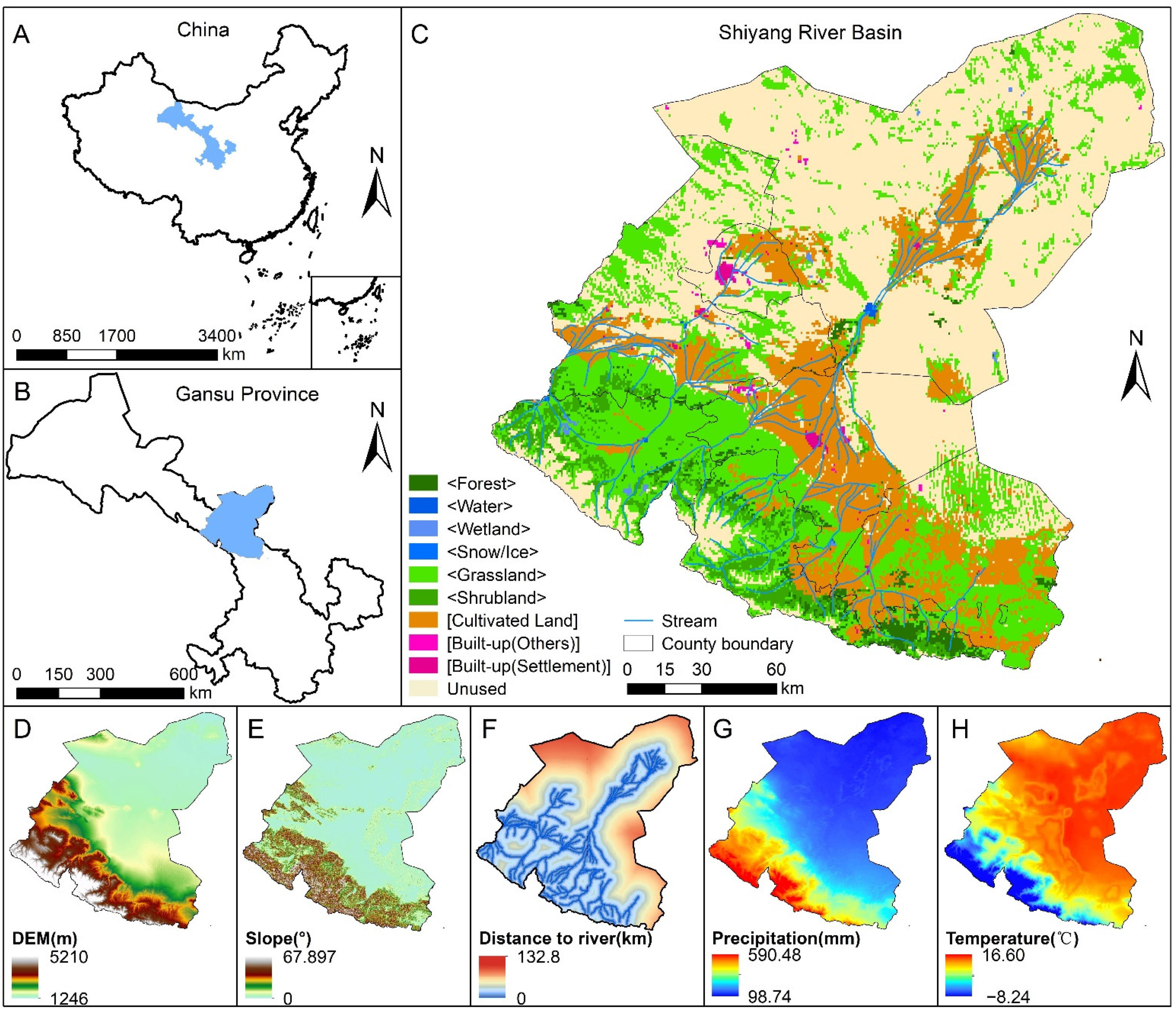
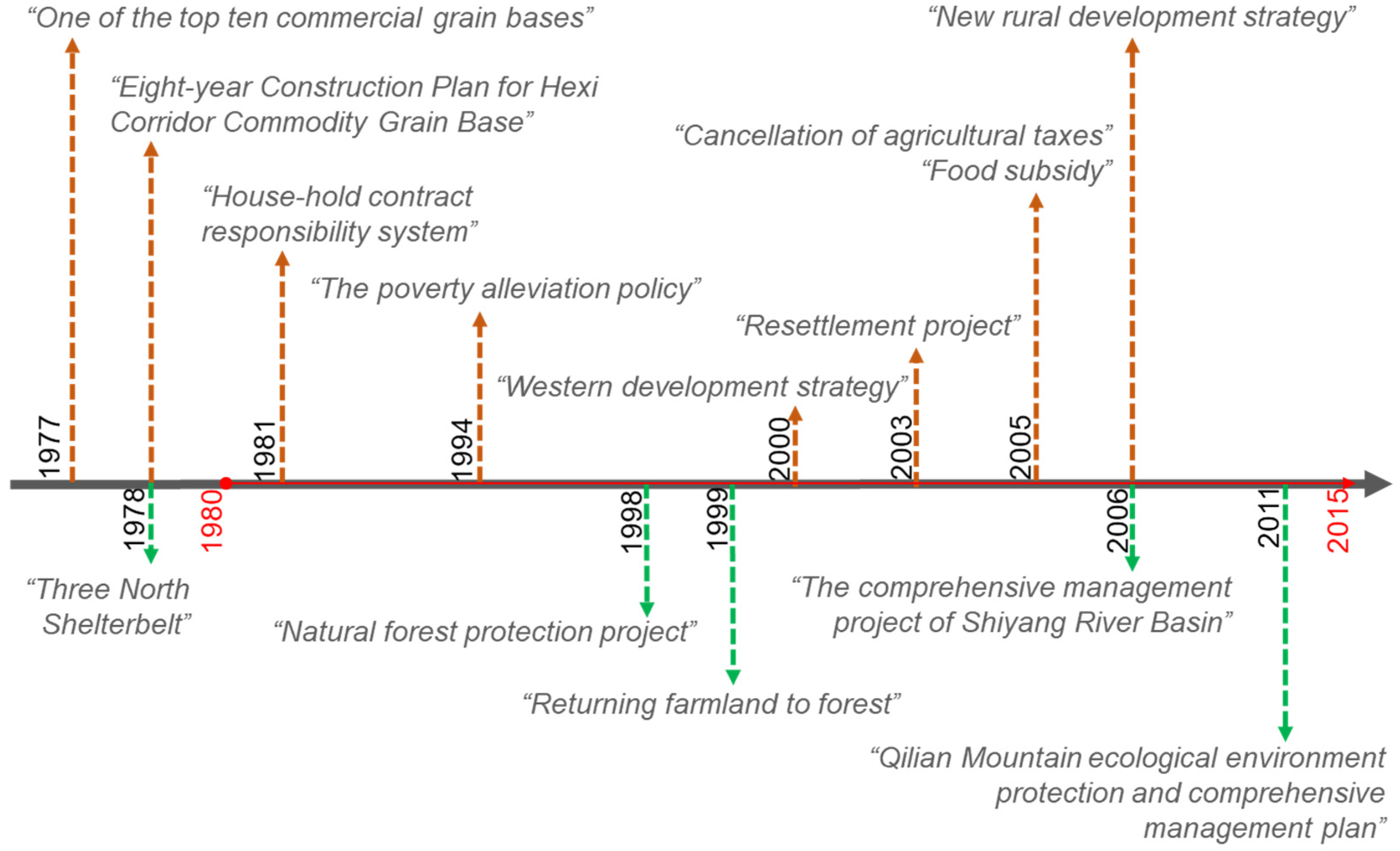

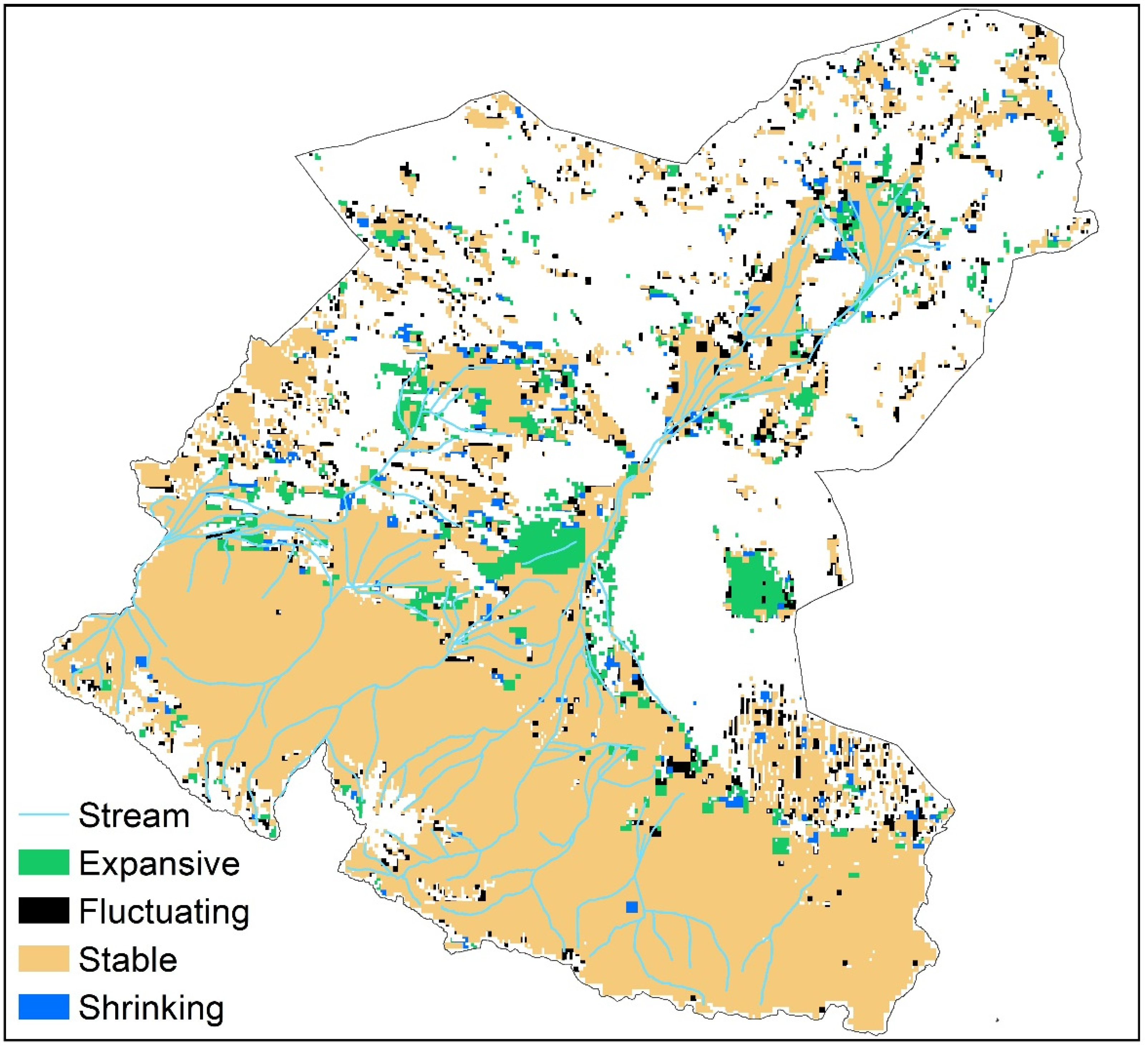
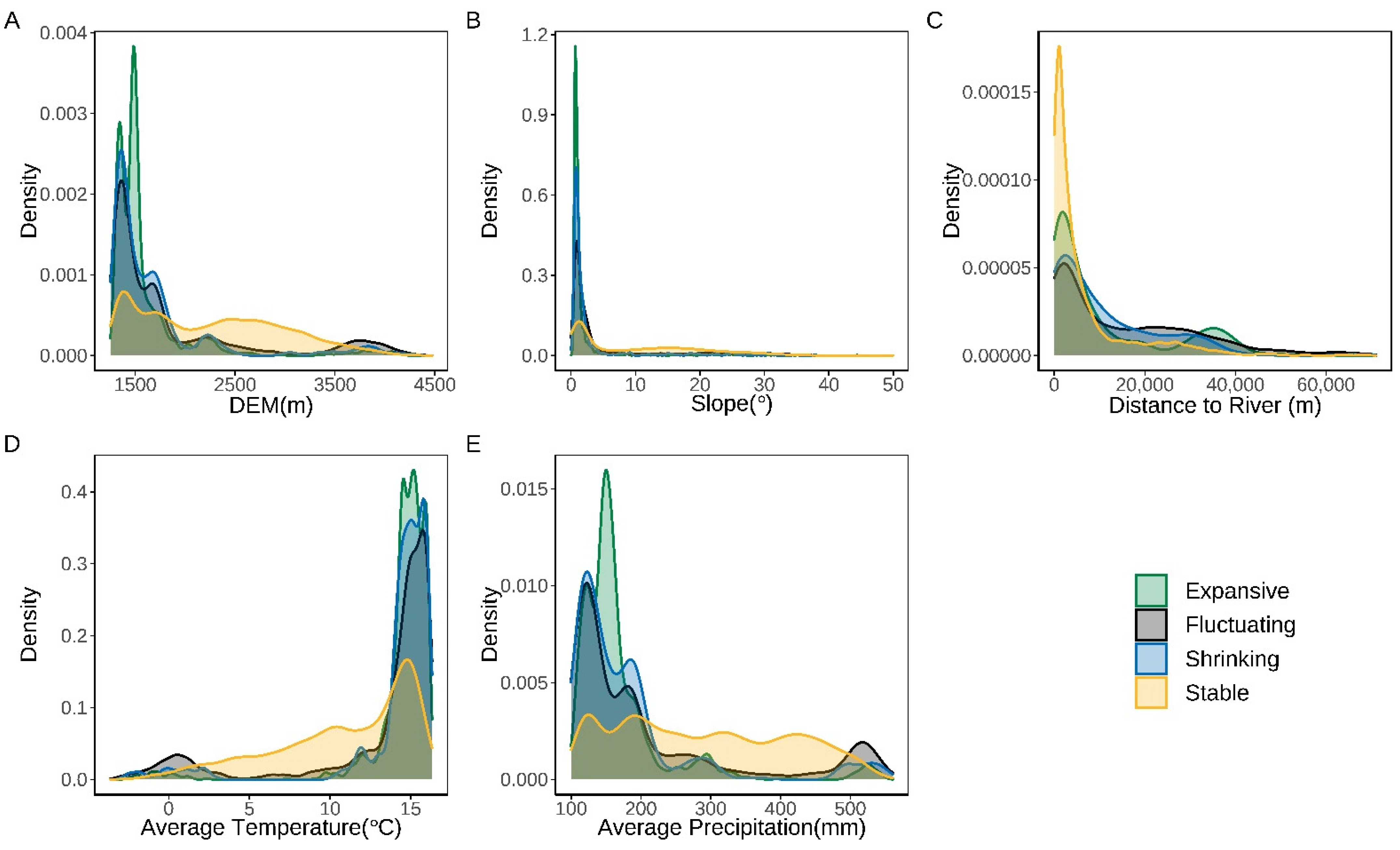
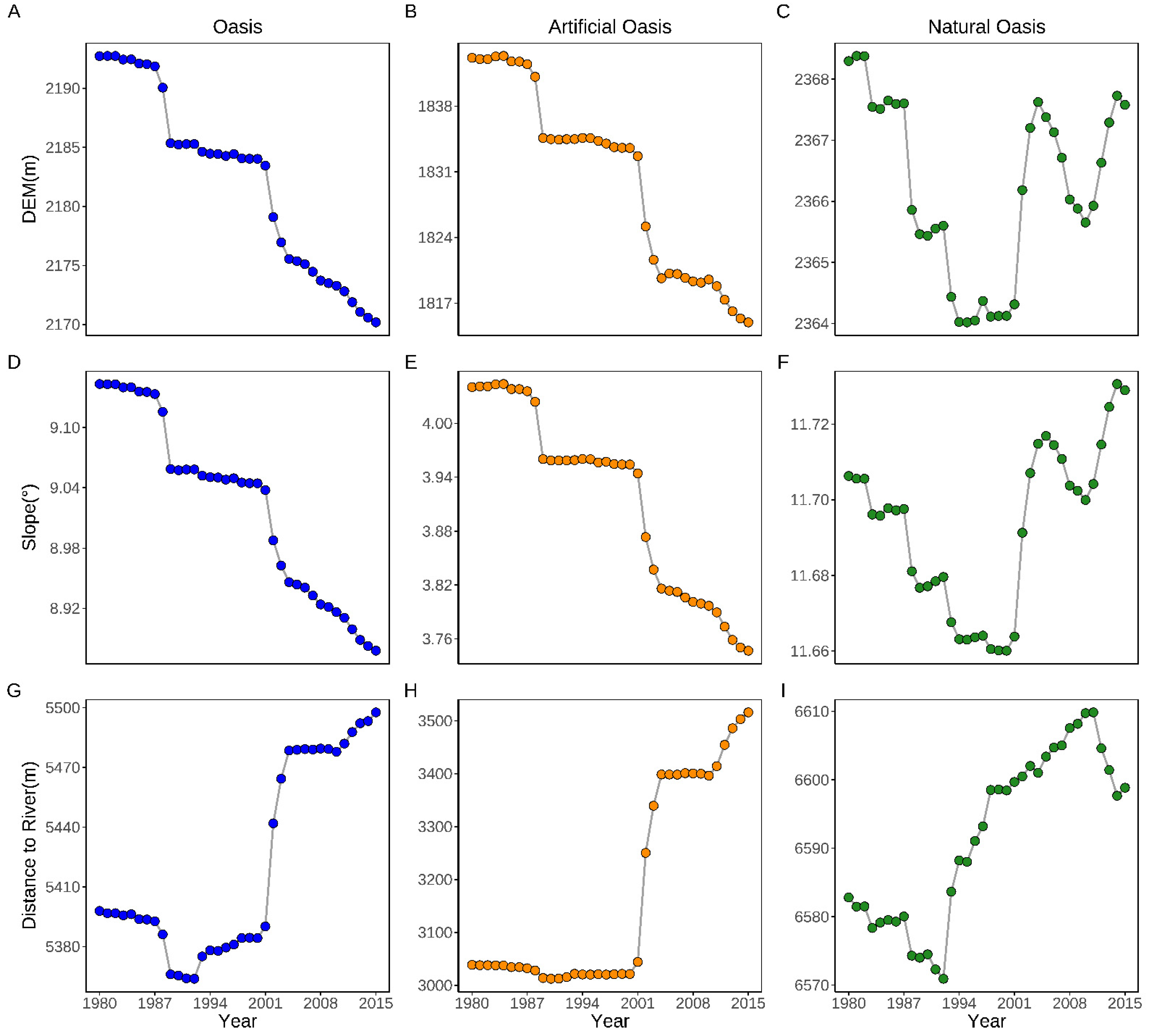
| 1980–2015 | 1980–2000 | 2001–2015 | |||||||
|---|---|---|---|---|---|---|---|---|---|
| Total | Artificial | Natural | Total | Artificial | Natural | Total | Artificial | Natural | |
| Population | 0.71 *** | 0.66 *** | −0.15 | 0.83 *** | 0.79 *** | 0.93 *** | −0.72 ** | −0.70 ** | 0.50 |
| GDP | 0.94 *** | 0.93 *** | −0.84 *** | 0.95 *** | 0.89 *** | 0.88 *** | 0.92 *** | 0.91 *** | −0.70 ** |
| Primary Industry | 0.91 *** | 0.90 *** | −0.80 *** | 0.93 *** | 0.85 ** | 0.89 *** | 0.91 *** | 0.90 *** | −0.72 ** |
| Secondary Industry | 0.94 *** | 0.93 *** | −0.83 *** | 0.95 *** | 0.89 *** | 0.88 *** | 0.91 *** | 0.88 *** | −0.65 ** |
| Tertiary Industry | 0.90 *** | 0.89 *** | −0.82 *** | 0.93 *** | 0.91 *** | 0.85 ** | 0.88 *** | 0.87 *** | −0.72 ** |
| Grain Yield | 0.96 *** | 0.95 *** | −0.60 *** | 0.70 ** | 0.66 ** | 0.82 *** | 0.97 *** | 0.97 *** | −0.87 *** |
| Livestock Stock | 0.95 *** | 0.97 *** | −0.72 *** | 0.66 ** | 0.62 ** | 0.79 *** | 0.95 *** | 0.94 *** | −0.79 *** |
| Precipitation | 0.61 *** | 0.61 *** | −0.33 | 0.26 | 0.21 | 0.42 | 0.37 | 0.39 | −0.44 |
| Temperature | 0.78 *** | 0.77 *** | −0.26 | 0.59 ** | 0.59 ** | 0.60 ** | 0.16 | 0.19 | −0.27 |
| Wind Speed | −0.03 | 0.02 | −0.37 * | −0.52 * | −0.52 * | −0.45 * | 0.40 | 0.40 | −0.39 |
| Component.1 | Component.2 | Component.3 | |
|---|---|---|---|
| Population | 0.16 | 0.75 | 0.11 |
| GDP | 0.37 | −0.21 | −0.01 |
| Primary | 0.37 | −0.19 | 0.02 |
| Secondary | 0.37 | −0.19 | −0.06 |
| Tertiary | 0.37 | −0.24 | 0.06 |
| Grain Yield | 0.38 | 0.14 | −0.01 |
| Livestock | 0.38 | −0.02 | −0.07 |
| Precipitation | 0.24 | −0.03 | 0.22 |
| Temperature | 0.26 | 0.47 | 0.22 |
| Wind speed | 0.10 | 0.19 | −0.94 |
Publisher’s Note: MDPI stays neutral with regard to jurisdictional claims in published maps and institutional affiliations. |
© 2022 by the authors. Licensee MDPI, Basel, Switzerland. This article is an open access article distributed under the terms and conditions of the Creative Commons Attribution (CC BY) license (https://creativecommons.org/licenses/by/4.0/).
Share and Cite
Fang, Y.; Wang, X.; Cheng, Y.; Wang, Z. Oasis Change Characteristics and Influencing Factors in the Shiyang River Basin, China. Sustainability 2022, 14, 14354. https://doi.org/10.3390/su142114354
Fang Y, Wang X, Cheng Y, Wang Z. Oasis Change Characteristics and Influencing Factors in the Shiyang River Basin, China. Sustainability. 2022; 14(21):14354. https://doi.org/10.3390/su142114354
Chicago/Turabian StyleFang, Yu, Xulian Wang, Yufei Cheng, and Zhongjing Wang. 2022. "Oasis Change Characteristics and Influencing Factors in the Shiyang River Basin, China" Sustainability 14, no. 21: 14354. https://doi.org/10.3390/su142114354





